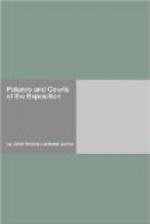Pass along to the first group beyond Helios, realizing that Robt. Aitken, the sculptor, calls this “The Dawn of Life.” From right to left are these figures:
1. The Hand of Destiny Giving Life. 2. The Prenatal Sleep of Woman. 3. The Awakening. 4. The Joy of Living. 5. The Kiss of Life. 6. The Bringing Forth of Life.
The elemental feelings are here suggested.
You will then notice a gap which stands for the unknown period of history after the first “Dawn of Life.”
-
Now pass to Panel 1 (facing Helios).
The central figure is Vanity, one of the compelling motives of that early life.
Following are two fine figures carrying their children, expressing the idea of the fecundity of the early races.
-
A hermes divides this panel from the next. Since in classic times a herm, or hermes, was used to mark distances on the roads, so here the hermes is used to mark distances, or periods in time.
-
Panel 2 — We now see the successors of the children of the previous panel grown to manhood. The fact of Natural Selection inflicts itself upon man. Two women are attracted to the same male, a fine intellectual and physical type. The rejected suitors are seen at the end of the panel, one in anger, the other in despair.
-
Panel 3 is called The Survival of the Fittest. This is the suggestion that physical strength decides who shall survive. We notice that chieftains struggle to possess the same woman, a woman on the right endeavoring to separate them.
-
Panel 4 is called The Lesson of Life.
Elders of experience attempt to give counsel to the love-lorn and impetuous, knowing that impulse may sometimes be a poignant foe.
Returning to Panel 1, the two figures at the right represent Lust, another of the strong forces of the early peoples.
You have now reached your first group beyond the gap.
The first figure is Greed, the third motive in this history of life. He has been holding onto the material things of life — there they are, rolled into a great ball. He realizes how futile his life has been and looks back upon the past, longing to retrace his steps and live to nobler purpose.
Then comes the old man who has the spiritual understanding, and he knows that the only hope for his companion is the realization of the spiritual, the consciousness of immortality, and so he gives to her the winged beetle, the symbol of renewed life.
The time has now arrived for her to leave her mortal life, and she passes into that sleep by which her material body is cast aside.
Thereby the man has his first sorrow. She whom he loved is gone, and he is cast down in despair — because his outlook is not a spiritual one.
The hand of Destiny has drawn these lives unto itself. The law has been fulfilled.




